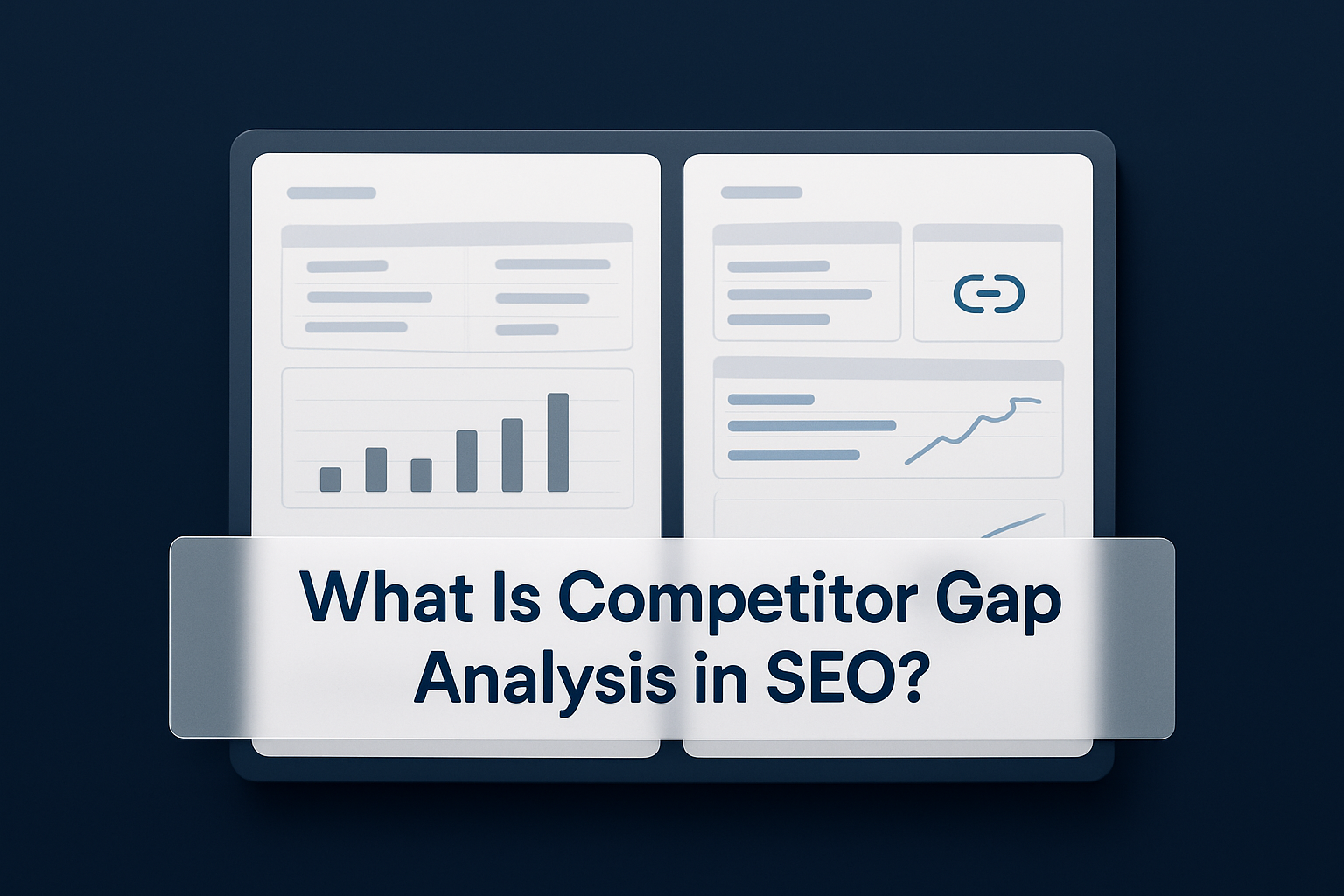
Table of Contents
“Your biggest competitor’s weakness is your greatest opportunity.” This principle drives successful SEO strategies across industries. While many businesses focus on their own optimization efforts, the smartest companies look beyond their websites to understand what their competitors are doing right—and more importantly, what they’re missing. Competitor gap analysis transforms your SEO approach from reactive to strategic. Instead of guessing what might work, you gain clear insights into proven opportunities within your market. This process reveals untapped keywords, content gaps, and technical advantages that can accelerate your organic growth.
What Is Competitor Gap Analysis in SEO?

In India’s competitive digital landscape with over 60 million small businesses, understanding where you stand against competitors isn’t just helpful—it’s essential for survival. Competitor gap analysis serves as your strategic roadmap, revealing exactly where your SEO efforts fall short and where opportunities lie waiting.
Think of it this way:
Competitor gap analysis examines the differences between your website’s performance and your competitors’ strengths and weaknesses. This systematic approach identifies opportunities where competitors rank well but you don’t, and areas where you can capitalize on their oversights.
Systematic Performance Comparison
The foundation of competitor gap analysis lies in methodical comparison. You’re not just looking at who ranks higher—you’re dissecting why they rank higher and what gaps exist in your strategy.
This process reveals patterns in your competitive landscape. Maybe your competitors dominate local search terms while you focus on broader keywords. Or perhaps they’ve mastered featured snippets while your content lacks the structured format Google prefers.
For B2B SaaS companies targeting India’s growing SMB market, projected to reach $74.7 billion, competitor gap analysis becomes even more critical.
Keyword Gap Identification
Find high-value keywords your competitors target that you’re missing.
Keyword gaps represent missed revenue opportunities. When competitors rank for terms your target audience searches for, they’re capturing traffic that should be yours.
Start by analyzing competitor keyword portfolios. Which terms drive their organic traffic? What search volumes do these keywords have? Most importantly, which ones align with your business goals but don’t appear in your current strategy?
Here’s what makes keyword gap identification powerful:
Marketing teams often discover competitors rank for industry terms they never considered. D2C brands find product-related keywords driving competitor sales. The key lies in identifying keywords that match user intent while fitting your content capabilities.
Content Opportunity Mapping
Spot topics and formats that drive traffic to competitor sites.
Content gaps extend beyond keywords into topics, formats, and user experience elements. Your competitors might excel at how-to guides while you focus on product comparisons. They could dominate video content while you stick to blog posts.
Successful content opportunity mapping examines:
- Topic clusters competitors cover comprehensively
- Content formats generating the most engagement
- User questions competitors answer that you don’t
- Content depth and quality differences
Technical Performance Comparison
Analyze site speed, mobile optimization, and user experience differences.
Technical gaps often create the biggest competitive disadvantages. If competitors’ sites load faster, rank higher in mobile searches, or provide better user experiences, they’ll consistently outperform you regardless of content quality.
Focus on measurable technical factors:
Site speed directly impacts rankings and user retention. Mobile optimization affects how Google crawls and indexes your content. User experience signals influence whether visitors convert into customers.
Technical competitor gap analysis reveals actionable improvements that can quickly close performance gaps and boost your competitive position.
How to Conduct Effective Competitor Gap Analysis

With India’s 60+ million SMBs contributing 30% to the country’s GDP (Economic Times), understanding your competitive position becomes critical for sustainable growth. Effective competitor gap analysis reveals exactly where your SEO strategy falls behind and which opportunities remain untapped in this expanding market.
Competitor Selection Criteria
Choose 3-5 direct competitors who target similar audiences and keywords within your specific market segment. Focus on businesses competing for the same customer base rather than industry giants who operate in different spheres.
Start with these selection factors:
- Companies ranking for your primary target keywords
- Businesses serving similar customer segments in your geographic region
- Organizations with comparable business models and pricing structures
- Competitors mentioned frequently in customer research or sales conversations
The SMB software market’s projected growth of 8.2% CAGR through 2029 means your competitor gap analysis must account for emerging players alongside established ones.
Data Collection Methodology
Gather comprehensive information across four critical areas: organic keywords, backlinks, content performance, and technical metrics. This systematic approach ensures your competitor gap analysis captures both visible and hidden competitive advantages.
Essential data collection includes:
- Keyword rankings and search volume data
- Backlink profiles and domain authority metrics
- Content performance indicators like social shares and traffic estimates
- Technical SEO factors including site speed and mobile optimization
With MSMEs generating 40% of India’s manufacturing output (Economic Times), your data collection must reflect sector-specific competitive dynamics.
Analysis Framework Setup
Create systematic processes to compare performance across content, technical, and authority factors. Structure your competitor gap analysis using standardized metrics that translate into actionable improvements.
Build comparison frameworks for:
- Content gaps where competitors rank but you don’t
- Technical performance differences affecting user experience
- Authority-building opportunities through strategic partnerships
- Geographic or demographic segments your competitors neglect
Your analysis framework should address the specific challenges Indian SMBs face, including rising costs and limited credit access, positioning your findings within this ₹1,955 billion market opportunity.
Key Areas to Analyze for Maximum Impact

Competitor gap analysis reveals strategic opportunities that can transform your organic search performance. With India’s 60+ million small businesses contributing 30% to the country’s GDP), understanding where competitors fall short becomes mission-critical for sustainable growth.
Effective competitor gap analysis covers four critical areas that directly impact search rankings and organic traffic. Each area provides unique insights that inform different aspects of your SEO strategy.
Content Gap Analysis
Identify missing topics, content formats, and keyword clusters in your content strategy by examining what competitors publish versus what you offer. Look for trending topics in your industry that competitors haven’t covered yet.
This process reveals content opportunities where you can establish thought leadership. With the SMB software market growing at 8.2% CAGR between 2024-2029 (Technavio), businesses need fresh perspectives on emerging challenges like access to affordable credit and rising operational costs.
Backlink Opportunity Assessment
Find high-authority sites linking to competitors but not to your content. This competitor gap analysis technique uncovers potential partnership opportunities and guest posting prospects.
Focus on industry publications, trade associations, and thought leadership platforms. Since MSMEs generate 40% of India’s manufacturing output, target manufacturing-focused publications where competitors already have established relationships.
Technical SEO Comparison
Compare site architecture, page speed, mobile optimization, and user experience factors against top competitors. Technical gaps often provide quick wins for organic rankings.
Audit competitors’ Core Web Vitals, schema markup implementation, and mobile responsiveness. Many businesses overlook technical optimization while focusing solely on content creation, creating opportunities for those who prioritize comprehensive competitor gap analysis across all technical elements.
Turning Gap Analysis into Actionable SEO Strategy

Your competitor gap analysis research means nothing without a clear execution plan. The real value of competitor gap analysis lies in transforming insights into executable improvements. This requires prioritizing opportunities based on potential impact and your available resources.
Most marketing teams get stuck between analysis and action. They identify competitor advantages but struggle to create systematic improvement plans that drive measurable results.
Opportunity Prioritization Matrix: Rank Gaps by Search Volume, Competition Level, and Alignment with Business Goals
Create a scoring system that weighs each opportunity against three critical factors. Search volume indicates potential traffic, while competition difficulty reveals resource requirements. Business alignment ensures your efforts support revenue goals rather than vanity metrics.
Score each gap on a 1-10 scale across these dimensions. A high-volume keyword with moderate competition that aligns perfectly with your product offering scores higher than a trending topic outside your niche.
Implementation Roadmap Creation: Develop Timelines for Content Creation, Technical Improvements, and Link Building Initiatives
Build monthly sprint cycles that tackle high-priority gaps systematically. Content creation typically requires 2-4 weeks per piece, depending on research depth and technical complexity. Technical improvements often need developer resources and longer implementation windows.
Break your roadmap into quarterly themes. Q1 might focus on content gaps, Q2 on technical optimization, and Q3 on link building initiatives. This prevents resource conflicts while maintaining steady progress across all fronts.
Consider India’s manufacturing sector challenges, including [rising costs and weak demand] (https://economictimes.indiatimes.com/small-biz/sme-sector/how-is-the-economy-really-doing-indias-63-million-small-businesses-may-have-the-answer/articleshow/104067736.cms?from=mdr). Your content roadmap should address these pain points where competitors fall short.
Performance Tracking Setup: Monitor Progress Against Competitors Using Consistent Metrics and Reporting Intervals
Establish baseline measurements before implementing changes from your competitor gap analysis. Track ranking improvements, organic traffic growth, and conversion rate changes monthly. Compare your progress against the same competitors you initially analyzed.
Create automated reports that highlight wins and identify new gaps as they emerge. Your competitors won’t stay static, so your monitoring system must capture their moves while measuring your advancement.
Set up alerts for significant ranking changes in target keywords. This early warning system helps you respond quickly when competitors launch new initiatives or when your improvements start showing results.
The path from analysis to achievement requires structured execution and consistent measurement across every initiative.
Conclusion
Competitor gap analysis provides the roadmap for strategic SEO improvements that can transform your organic performance. The key lies in systematic implementation and continuous monitoring to stay ahead of market changes. Start by focusing on the highest-impact opportunities you’ve identified. Quick wins in content gaps can provide immediate traffic boosts while you work on longer-term technical and authority-building initiatives. Remember that your competitors aren’t standing still—regular analysis ensures you maintain your competitive advantage.
Ready to automate your entire competitor analysis workflow? Creator’s AI-powered platform handles comprehensive competitor research alongside technical audits, content creation, and performance tracking—giving you everything needed to outrank competitors without the manual work or multiple tools.



